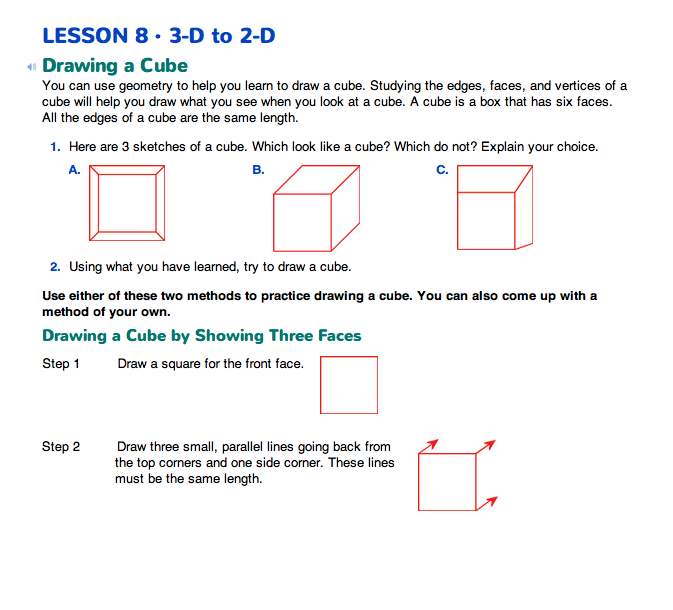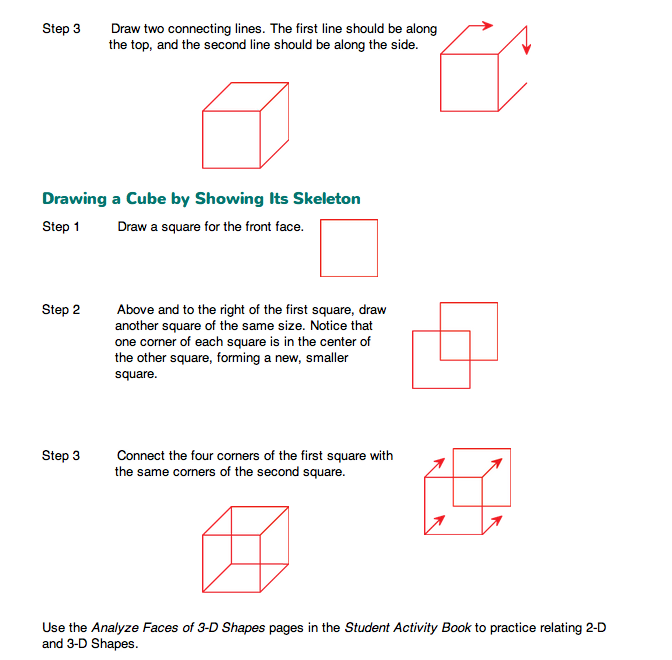View Rectangular Prisms. Distribute empty cereal and tissue boxes and cubes collected previously to groups of two to four students. Remind students that all of these are examples of rectangular prisms. Ask students to share the box for their group and have them touch first the edges, then a vertex, and finally a face of their prism.
- What is the shape of each face? (a rectangle or square depending upon the group's shape)
- How many faces does your prism have? (6 faces)
- How many edges does your prism have? (12 edges)
- How many vertices does your prism have? (8 vertices)
- Can the shortest group member touch parallel faces at the same time? Try it. (yes)
- Can the tallest group member touch a different set of parallel faces at the same time? Try it. (yes)
- Is there another set of parallel faces for the remaining group members to touch together? Try it. (yes)
- Move the box around to see different views.
- What do you have to do to see only one face? (Hold it directly in front of my face at eye-level.)
- Move the box around so that you see only two faces. Tell what you did. (I focused on an edge.)
- Hold the box so that you are looking directly at one vertex. How many faces can you see? (3 faces)
- Can you see four faces at once? (No, you can see only 3 faces at a time.)
- How many faces does a prism have? (6 faces)
Hold up a cube from the classroom set of solids so it is visible to all.
- Is a cube a rectangular prism? (yes)
- What shape is each face? (a square)
- How many faces are there? (6 faces)
- How many edges does a cube have? (12 edges)
- Hold the cube so that you see three faces by looking at one vertex. What three shapes do you see? (3 squares)
Draw a Cube. Read together and discuss Drawing a Cube on the 3-D to 2-D pages in the Student Guide. Question 1 presents students with two inaccurate drawings and one accurate depiction of a cube. Students should be able to identify the second drawing (B) as correct and identify the mistakes in the other two drawings. The first drawing (A) shows too many faces and edges. The appropriate edges in the third drawing (C) are not parallel to one another. Ask students to justify their response using properties of a cube including:
- opposite edges are parallel
- each face is a congruent square
- all vertices are right angles
Question 2 asks students to try drawing a cube based on their work so far. The drawings students make for this question can be used for comparison with the ones students will make by following the directions in the next section. This section describes two possible methods for sketching a cube. Students should not be confined to using only these two methods. Encourage them to use and to share their own methods as well.
Guide students in completing the steps for Drawing a Cube by Showing Three Faces as you demonstrate the process. Repeat this process for Drawing a Cube by Showing Its Skeleton.
Allow students to experiment drawing cubes of various sizes then discuss:
- Which method did you find easier, showing three faces or showing the skeleton? Why?
- How can you use either of these methods to draw a rectangular prism that is not a cube? (Possible response: You could start like a cube but make the edges at the top and the bottom connecting the front and back faces longer than the edges of the square faces.)
- Which other 3-D shapes do you think you can draw using either of these methods? (Possible response: a triangular prism)
- Which shapes would not be possible to draw with either of these methods? Why? (Possible response: the cone, sphere, and cylinder because of the curved faces or surfaces; the pyramids because the vertices meet at the top)













